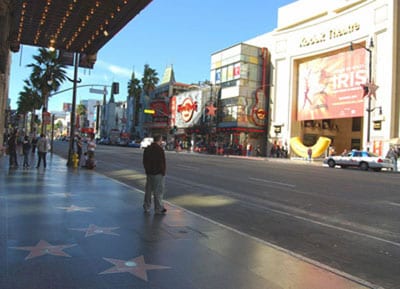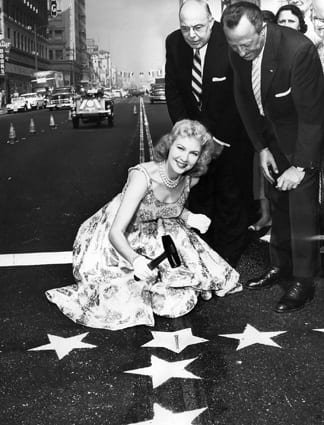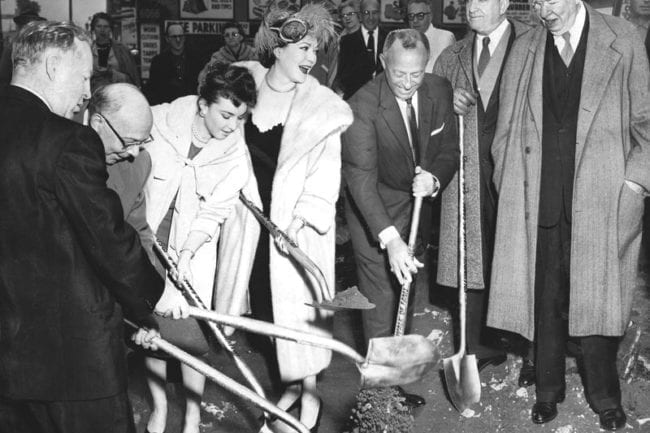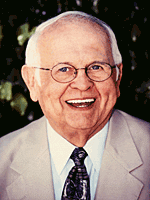
The stars on the world-famous
Hollywood Walk of Fame
are located on both sides of
Hollywood Boulevard and Vine Street.
The Hollywood Walk of Fame is an internationally-recognized Hollywood icon. With about 24 induction ceremonies annually broadcast around the world, the constant reinforcement provided to the public has made the Walk of Fame a top visitor attraction. The Hollywood Walk of Fame is undoubtedly one of the most successful marketing ideas ever produced. Unfortunately, there is a lot of inaccurate information circulating about the history of the Walk. We present this brief history to set the record straight.
 The man credited with the idea for creating a Walk of Fame, was E. M. Stuart, who served in 1953 as the volunteer president of the Hollywood Chamber of Commerce. In that year, according to a Chamber press release he proposed the Walk as a means to “maintain the glory of a community whose name means glamour and excitement in the four corners of the world.” He appointed a committee to begin fleshing out the idea and the architectural firm of Periera and Luckman was employed to develop some specific proposals. Where the original idea came from is not certain; however, the ceiling of the dining room of the historic Hollywood Hotel once had stars painted on the ceiling with the names of celebrities and that may have been a precursor of the idea to place stars in the sidewalks.
The man credited with the idea for creating a Walk of Fame, was E. M. Stuart, who served in 1953 as the volunteer president of the Hollywood Chamber of Commerce. In that year, according to a Chamber press release he proposed the Walk as a means to “maintain the glory of a community whose name means glamour and excitement in the four corners of the world.” He appointed a committee to begin fleshing out the idea and the architectural firm of Periera and Luckman was employed to develop some specific proposals. Where the original idea came from is not certain; however, the ceiling of the dining room of the historic Hollywood Hotel once had stars painted on the ceiling with the names of celebrities and that may have been a precursor of the idea to place stars in the sidewalks.
It was not until 1955 that the basic tenets of the proposal were agreed upon, and in that year, the Hollywood Chamber of Commerce proceeded to secure the necessary signatures to present to the City for further action in the formation of an assessment district. These plans were crystallized and submitted to the Los Angeles City Council in January of 1956. The Council embraced the idea and instructed the Board of Public Works to prepare the engineering specifications and to create the necessary assessment district to pay for the improvements.
As plans progressed, various concepts were reviewed. In February of 1956, a proposed rendering of a star was unveiled that included a caricature of the honoree, with a proposal for brown and blue sidewalks. It was later determined that caricatures would be too difficult to develop and the colors of the sidewalk were changed to black and coral. It is said that Hollywood businessman C.E. Toberman nixed the idea of the brown and blue sidewalks because they did not complement a new building he was erecting on the Boulevard.
The Chamber established the Hollywood Improvement Association to work with the City in pursuing the idea. The man who was selected to chair the effort was Harry Sugarman, a prominent businessman whose family had been film exhibitors and owned one of California’s oldest theatres. He saw the project through to completion.
While the City worked on creation of the assessment district, the Improvement Association moved forward between May 1956 and the fall of 1957 in selecting the honorees to be initially placed in the Walk. Four committees were established to represent the four different aspects of the entertainment industry at that time – motion picture, television, recording and radio. The committees included some of the most prominent names in entertainment. Members of the Motion Picture Selection Committee included Cecil B. DeMille, Samuel Goldwyn, Jesse Lasky, Walt Disney, Hal Roach, Mack Sennett and Walter Lantz, among others. Once the effort began, suggestions began pouring in to the Chamber offices – as many as 150 names a week were submitted.
Meanwhile, the City was finalizing plans for the assessment district. The cost to build the Walk, including new street lighting and street trees, was determined to be $1.25-million. This worked out to $85 per front foot to be paid by the adjacent property owners.
 On August 15, 1958, the Chamber and City unveiled eight stars on Hollywood Blvd. at Highland Avenue to create excitement and to demonstrate what the Walk would look like. The eight honorees included: Olive Borden, Ronald Colman, Louise Fazenda, Preston Foster, Burt Lancaster, Edward Sedgwick, Ernest Torrence, and Joanne Woodward. Construction on the Walk was expected to begin shortly thereafter.
On August 15, 1958, the Chamber and City unveiled eight stars on Hollywood Blvd. at Highland Avenue to create excitement and to demonstrate what the Walk would look like. The eight honorees included: Olive Borden, Ronald Colman, Louise Fazenda, Preston Foster, Burt Lancaster, Edward Sedgwick, Ernest Torrence, and Joanne Woodward. Construction on the Walk was expected to begin shortly thereafter.
On February 8, 1960, construction actually began on the long-planned Walk. The first star to be laid in the new Walk was that of Stanley Kramer on March 28, 1960, near the intersection of Hollywood and Gower. By that fall, work had progressed far enough that it was decided to dedicate the Walk on November 23, 1960, in conjunction with the Hollywood Christmas Parade. E.M. Stuart, as the originator of the idea, was appointed chair of the Completion Committee and planned the ceremony to mark completion of the project. The job was not actually completed until spring 1961, when it was finally accepted by the Board of Public Works, with the first 1,558 stars.
Shortly after completion, it was recognized that in order to continue the original intent of the program for the addition of more names in the vacant stars, a mechanism had to be created. On May 18, 1962, the Los Angeles City Council approved an ordinance that specified the Hollywood Chamber of Commerce should be the agent to advise the City in all matters pertaining to the addition of other names. The Chamber faced three tasks in moving forward: (1) to establish a set of rules to determine the qualifications of personalities to be eligible for addition to the Walk of Fame, (2) to work out a procedure to process candidates, and (3) to develop a plan for the financing of the costs of the addition of approved names. The task took several years, and it was not until December 11, 1968, that another star was added. Actor/comedian Danny Thomas hosted the momentous star unveiling for producer/studio executive Richard D. Zanuck in front of the world-famous Grauman’s Chinese Theatre. From this time forward, star ceremonies were held on a fairly regular basis. In 1972, Charlie Chaplin was awarded a star on the Walk of Fame. By May 21, 1975, when Carol Burnett received her honors, a total of 99 stars had been added to the original Walk.
 In 1978, the Cultural Heritage Board of the City of Los Angeles designated the Hollywood Walk of Fame as Los Angeles Historic-Cultural Monument #194. In 1980, the Chamber presented a star to entertainer Johnny Grant. Johnny became enthused about the honor and involved himself in creating a very memorable star ceremony. The Chamber was so impressed with his efforts, that they approached him about chairing the Walk of Fame Committee, which he accepted. From then, until his death in January 2008, Johnny’s name became synonymous with the Walk of Fame. His strong leadership built the Walk into an international icon. Under his leadership, a fifth category of “Live Theatre” was added in 1984 to allow persons who excelled in all types of live performance to be considered for stars. He also solved the problem of running out of space to add stars. When constructed, the Walk was designed to accommodate 2,518 stars. By the 1990s, space in the most popular areas was becoming difficult to find. To solve the problem, Johnny approved the creation of a second row of stars on the sidewalk, which would alternate with the existing stars. For more about Hollywood’s beloved honorary mayor Johnny Grant, go to: www.johnnygrant.com.
In 1978, the Cultural Heritage Board of the City of Los Angeles designated the Hollywood Walk of Fame as Los Angeles Historic-Cultural Monument #194. In 1980, the Chamber presented a star to entertainer Johnny Grant. Johnny became enthused about the honor and involved himself in creating a very memorable star ceremony. The Chamber was so impressed with his efforts, that they approached him about chairing the Walk of Fame Committee, which he accepted. From then, until his death in January 2008, Johnny’s name became synonymous with the Walk of Fame. His strong leadership built the Walk into an international icon. Under his leadership, a fifth category of “Live Theatre” was added in 1984 to allow persons who excelled in all types of live performance to be considered for stars. He also solved the problem of running out of space to add stars. When constructed, the Walk was designed to accommodate 2,518 stars. By the 1990s, space in the most popular areas was becoming difficult to find. To solve the problem, Johnny approved the creation of a second row of stars on the sidewalk, which would alternate with the existing stars. For more about Hollywood’s beloved honorary mayor Johnny Grant, go to: www.johnnygrant.com.
On February 1, 1994 (which was Hollywood’s birthday anniversary), the Walk of Fame was extended one block to the west from Sycamore to LaBrea on Hollywood Blvd. as part of a revitalization project by the Los Angeles Community Redevelopment Agency. Thirty stars were added to the block to create an instant attraction. At this time, Sophia Loren was honored with the 2,000th star on the Hollywood Walk of Fame.
Today, the Hollywood Chamber of Commerce continues to add stars to the Walk of Fame as the representative of the City of Los Angeles. An average of two stars are added to the Walk on a monthly basis. The Walk is a tribute to all of those who worked so hard to develop the concept and to maintain this world-class tourist attraction.
